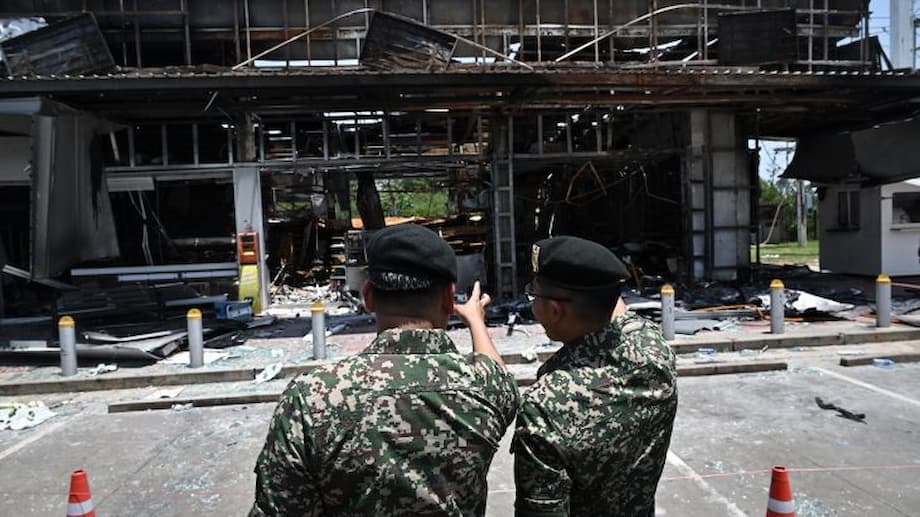Fragile Ceasefire Brings Hope and Anxiety to Thailand-Cambodia Border Communities
After five days of intense fighting along the disputed Thailand-Cambodia border, a fragile ceasefire brokered in Malaysia has brought a tense calm to the region. Yet, for the tens of thousands of civilians displaced by the violence, the return to normal life remains uncertain. As diplomatic talks continue and troops remain stationed alarmingly close, local residents and international observers alike are watching anxiously, hoping that the truce will hold and pave the way for lasting peace.
- Fragile Ceasefire Brings Hope and Anxiety to Thailand-Cambodia Border Communities
- How Did the Conflict Erupt?
- Ceasefire Negotiations: Who Stepped In?
- Is the Ceasefire Holding?
- Why Is the Border So Contentious?
- International Stakes: Why the World Is Watching
- Life on the Border: Stories of Hope and Uncertainty
- What Comes Next?
- In Summary
How Did the Conflict Erupt?
The roots of the 2025 Thailand-Cambodia border conflict stretch back more than a century, to colonial-era treaties and unresolved disputes over territory. The most contentious area is around the Preah Vihear Temple, an 11th-century Hindu monument perched atop a cliff. Although the International Court of Justice (ICJ) ruled in 1962—and reaffirmed in 2013—that the temple belongs to Cambodia, Thailand has never fully accepted the decision. Nationalist sentiment on both sides has kept the issue alive, periodically sparking military confrontations.
The latest flare-up began in late May 2025, when a Cambodian soldier was killed in a border skirmish. Tensions escalated further after a landmine explosion in July killed five Thai soldiers, prompting Thailand to downgrade diplomatic relations and recall its ambassador. The situation deteriorated rapidly, with both sides accusing each other of aggression and launching artillery, rocket, and airstrikes across the border. By July 24, full-scale fighting had erupted, resulting in dozens of deaths and the displacement of over 300,000 people from both countries.
Political Fallout and Nationalist Pressures
Domestic politics played a significant role in the escalation. In Thailand, a leaked phone call between Prime Minister Paetongtarn Shinawatra and Cambodia’s former leader Hun Sen caused a political uproar. In the call, Shinawatra appeared to criticize her own military’s actions, leading to her suspension and further inflaming nationalist anger. In Cambodia, the border dispute has long been used to rally public support and assert sovereignty, especially around the Preah Vihear Temple.
Ceasefire Negotiations: Who Stepped In?
With violence intensifying and civilian casualties mounting, international actors moved quickly to mediate. Malaysia, as chair of the Association of Southeast Asian Nations (ASEAN), hosted emergency talks in Kuala Lumpur. The United States and China, both with significant strategic interests in Southeast Asia, also participated. U.S. President Donald Trump played a particularly direct role, threatening to halt trade negotiations with both countries unless they agreed to a truce. Chinese officials, meanwhile, urged restraint and offered support for peacekeeping efforts.
On July 28, after days of shuttle diplomacy, Thai and Cambodian leaders agreed to an immediate and unconditional ceasefire. Malaysian Prime Minister Anwar Ibrahim announced the deal, calling it a “vital first step towards de-escalation and the restoration of peace and security.” The agreement included commitments to halt troop movements, refrain from reinforcing positions, and establish direct communication channels between military commanders.
Terms of the Ceasefire
The ceasefire stipulated:
- An immediate halt to all hostilities along the border
- No reinforcement or movement of troops and heavy weapons in disputed areas
- Direct communication between military commanders to prevent misunderstandings
- International monitoring by ASEAN defense attaches, led by Malaysia
- Plans to establish a Cambodian-Thai General Boundary Committee to address long-term border issues
Is the Ceasefire Holding?
While the ceasefire has largely stopped the worst of the violence, the situation remains precarious. Both sides have accused each other of violating the truce. Thailand reported overnight attacks by Cambodian troops in Sisaket province, describing them as “flagrant violations” of the agreement. Cambodia has denied these allegations, insisting that its forces are merely holding their positions.
Thai government spokesperson Jirayu Huangsab stated, “The situation is still fragile. We are maintaining control, but the risk of renewed clashes remains.”
Military commanders from both countries have met along the border to reaffirm their commitment to the ceasefire and agree on de-escalation steps. These include a ban on firing at civilians and a halt to any troop reinforcements. International observers from Malaysia, China, and the United States are monitoring the situation, but mutual distrust lingers.
Local Impact: Displacement and Trauma
The human cost of the conflict has been severe. At least 43 people have been killed, most of them civilians, and over 300,000 have been displaced from their homes. In Thailand’s Ubon Ratchathani province alone, about 20,000 residents remain unable to return, their homes damaged or destroyed by artillery and rocket fire. Cambodian provinces bordering Thailand have also seen mass evacuations and widespread destruction.
Local residents describe scenes of chaos and fear as fighting erupted. Phian Somsri, a Thai villager, recounted fleeing her home as bombs fell, losing a close friend to a rocket strike. Netagit, a janitor, lost his house entirely and now faces an uncertain future. Many evacuees are living in temporary shelters, traumatized by the violence and anxious about what comes next.
Phian Somsri expressed her longing for peace: “I just want to go home and live a normal life again. We are tired of running and afraid of what might happen if the fighting starts again.”
Why Is the Border So Contentious?
The Thailand-Cambodia border stretches over 800 kilometers and is dotted with ancient temples and villages. Much of the boundary was drawn by French colonial authorities in the early 20th century, leaving many areas poorly demarcated and subject to competing claims. The Preah Vihear Temple, awarded to Cambodia by the ICJ, remains a flashpoint for nationalist sentiment in both countries.
Periodic clashes have erupted over the years, most notably in 2011, but the 2025 conflict is the deadliest in more than a decade. Both governments have used the dispute to rally domestic support, making compromise politically difficult. The presence of valuable natural resources and strategic military positions along the border further complicates efforts to resolve the dispute.
International Stakes: Why the World Is Watching
The border conflict has drawn in major powers because of Southeast Asia’s strategic importance. The United States has long-standing military ties with Thailand and sees the region as a bulwark against Chinese influence. China, meanwhile, is Cambodia’s largest trading partner and has invested heavily in its infrastructure and military. Both superpowers have urged restraint and offered to mediate, but their involvement also reflects a broader competition for influence in the region.
Analysts view the dispute as a test of international diplomacy and regional stability. The involvement of ASEAN, the U.S., and China underscores the potential for local conflicts to escalate into broader crises if not managed carefully.
Diplomatic Efforts and Future Prospects
Following the ceasefire, Thai and Cambodian defense ministers met in Kuala Lumpur to finalize guidelines for a permanent end to hostilities. The General Border Committee, with observers from Malaysia, China, and the U.S., agreed on measures to strictly enforce the truce, prevent troop movements, and protect civilians. Both sides pledged to restore trust and work towards a long-term resolution of their border disputes.
Cambodian Prime Minister Hun Manet thanked international mediators, saying, “It is time to start rebuilding trust and confidence going forward between Cambodia and Thailand.”
Thailand’s acting Prime Minister Phumtham Wechayachai echoed this sentiment, emphasizing the need for a peaceful resolution that protects sovereignty and the lives of citizens.
Life on the Border: Stories of Hope and Uncertainty
For those living along the border, the ceasefire has brought a measure of relief but little certainty. Many remain in shelters, unable to return home due to ongoing military presence and the risk of renewed fighting. Thai officials are assessing damage to civilian homes and considering compensation, but the process is slow and complicated by continued distrust between the two militaries.
District officials confirm that both sides are still reinforcing positions in some areas, and the proximity of troops—sometimes just 50 meters apart—keeps tensions high. Residents remain on high alert, with memories of the recent violence still fresh.
Wasawat Puangpornsri, a Thai parliament member from Ubon Ratchathani, observed, “The situation remains unstable. People want peace, but they are afraid to believe it will last.”
Despite the uncertainty, many locals express hope that ongoing diplomatic efforts will eventually bring stability. The trauma of displacement and loss is profound, but the desire for peace is even stronger.
What Comes Next?
The immediate priority for both governments is to maintain the ceasefire and prevent any further escalation. The establishment of the General Border Committee and international monitoring are positive steps, but the underlying issues—territorial claims, nationalist pressures, and historical grievances—remain unresolved. Long-term peace will require sustained dialogue, mutual trust, and perhaps new approaches to border demarcation and resource sharing.
For now, the people of the Thailand-Cambodia border region wait and hope. Their lives have been upended by a conflict not of their making, and their future depends on the willingness of leaders to put aside old animosities and work towards a lasting peace.
In Summary
- A fragile ceasefire brokered in Malaysia has halted the deadliest Thailand-Cambodia border conflict in over a decade, but tensions remain high.
- The dispute centers on long-standing territorial claims, especially around the Preah Vihear Temple, and is fueled by nationalist sentiment and political pressures in both countries.
- International mediation by Malaysia, the United States, and China was crucial in securing the truce, with ASEAN playing a key monitoring role.
- Both sides have accused each other of violating the ceasefire, and mutual distrust persists, with troops still stationed close to the border.
- Over 300,000 people have been displaced, with many unable to return home due to ongoing military presence and trauma from the conflict.
- Diplomatic talks continue, aiming for a permanent resolution, but the underlying issues remain unresolved.
- Local residents hope for peace but remain anxious about the future as negotiations and military movements continue.












